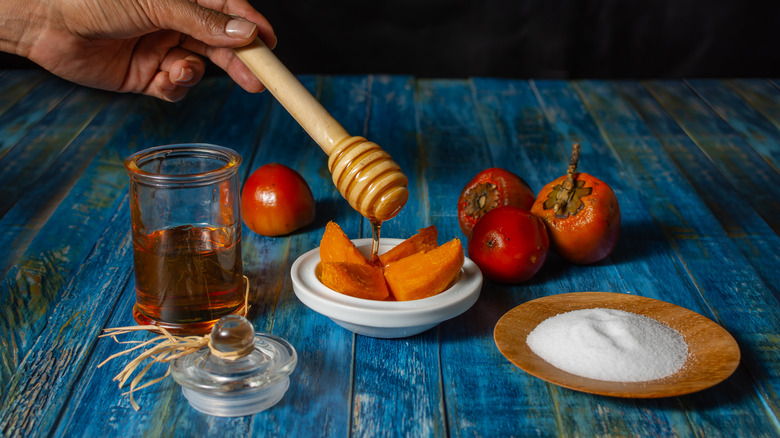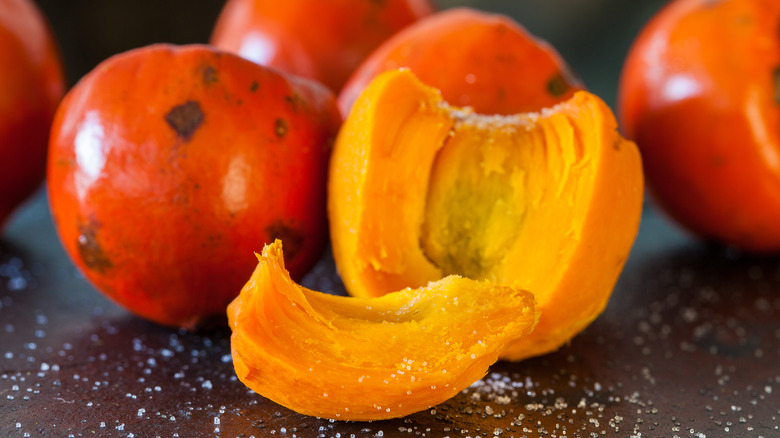The Nutty Fruit That Tastes Like A Sweet Potato
We may receive a commission on purchases made from links.
As the classic idiom goes, one can't compare apples and oranges, and the further one travels around the world, the more distinctive the local fruits of the lands become. While the average person may consider fruit to be a sweet addition or cooking ingredient in the standard diet, the scientific reality is that fruit is actually "the fleshy or dry ripened ovary of a flowering plant" (per Britannica). This definition settles any debate over whether a tomato is a fruit or vegetable. The range in how many different flavor profiles fruits can showcase points to the immense biodiversity found on our planet.
Certain countries, like Colombia, which ranks as the third most biodiverse country on earth (via Greenroofs), have more biodiversity and plants than others and thus have a wide range of fruits available for consumption that are hard to find elsewhere. While Colombians enjoy a ton of fruits native to their land, there is one starchy fruit that is a popular street food that you need to know — the chontaduro.
What is chontaduro?
The Spanish word chontaduro translates to a species of the palm tree, or more specifically, the peach-palm tree and the fruit it bears (per Tureng). According to Food Lve, the peach palm tree that bears the chontaduro fruit is native to the Pacific coast of Colombia and can also be found in other tropical climates elsewhere in South and Central America. The scientific name for the peach palm tree is bactris gasipaes, which stems from cachipay, the name locals use in the Magdalena River valley in the Colombian Andes region (via Feedipedia).
The peach palm tree is tall, standing from six meters in height and can reach up to 24 meters, with multiple stems and cream-colored, yellow flowers that bear shiny orange-red or yellow fruits that grow in heavy bunches; up to 20 kilograms of chontaduros, or around 80-100 of the tiny fruit that's an ovoid or heart shape, about three to five centimeters in diameter and four to six centimeters long (via Speciality Produce).
What chontaduro tastes like
The small chontaduro fruit has smooth skin, which may be slightly wrinkled and a little greasy (via Speciality Produce), and the interior resembles a sweet potato since it is dense, dry, and starchy when raw. Chontaduro is usually cooked before consumption (though, technically, it can be eaten raw though it'll have an acidic taste, per Amigo Foods). Once heat is added, the flesh is most similar to sweet potato. The chontaduro has a large seed inside, and according to one episode of Fierce Fruit, it "tastes like a sweet potato mixed with a nut." Other bloggers like the Open Minded Traveler find the fruit so rich that they've compared eating chontaduro to eating butter, though the texture is relatively dry.
However, it's not just the fruit of the peach palm tree that is consumed. Every part of the tree, from the trunk, the leaves, and even the seeds of the chontaduro, can be utilized and turned into cooking oil, flour, and a food source. Chontaduro is enjoyed by humans and animals since the nutty fruit is also used as feed for livestock.
How to cook and eat chontaduro
The easiest and most direct way to enjoy chontaduro is to head to the streets of Colombia to try the common roadside snack. When you're walking Colombian city streets, from the capital of Bogota to mountainous cities like Peira, all you need to do is look out for fruit sellers standing near a pile of red-orange and yellow-ish fruits.
Chontaduro sold as a street snack, is usually boiled for around five hours in salted water (per Colombia Co), and then, the chontaduro is served pre-peeled and cut (via Eat Your World). The fruit is often sold in bags already well-seasoned with salt, lemon, honey, or even milk. These additional acidic and sweet flavorings enhance the taste of the chontaduro fruit itself. If you can get your hands on raw chontaduro, you can prepare them by giving the fruit a good wash and then boil in salted water, though it can also be roasted or baked (via Slow Food Foundation for Biodiversity). Even the seed is edible and tastes like coconut (Speciality Produce).
Nutritional benefits of chontaduro
Chontaduro is an exceptionally nutritionally dense food, and according to ExpoJeg, the tiny fruit is compared to an egg because it contains a complete range of nutrients the body needs — carbohydrates, protein, fatty acids, amino acids, vitamins, minerals, and also provides fiber. Among the fatty acids found in chontaduro are omega 3 and omega 6, both essential to human growth and health, and must be consumed as the body cannot produce these on its own (via Mount Sinai and Harvard Health).
One recent study from 2023, which studied the impact of eating avocado, trout, whole grains, and fruit — most notably, including chontaduro — even found that this type of diet reduced inflammation. However, the health benefits of the chontaduro don't end there, as many Colombians believe that the tiny fruit is a natural aphrodisiac, according to Colombia Co. In Colombia, you can find aphrodisiac juices and energy drinks with the fruit (per Latin Market).
Other names, uses of chontaduro and where to buy
Per the Slow Food Foundation for Biodiversity, chontaduro also goes by cachipay, jijirre, bobi, cachipaes, pichuguao, pijuayo, pupunha, supa, tembé, and in Colombia is also called a "miniature coconut" (per Colombia Co).
One traditional drink in the Amazon is the chicha de chontaduro, made up of crushed fermented chontaduro mixed with water. This concoction slakes thirst and is super healthy, retaining all of the nutritional benefits of the fruit itself. According to Not Your Average American, in Ecuador, the chicha de chonta is a drink enjoyed at festivals and parties where people gather to work on a communal project. Other uses of the chontaduro include frying it, pickling it, and using it in sauces, soups, jellies, and jams, and the flesh itself can also be turned into flour for making bread, tortillas, or cakes. If you can't get to Colombia to try the fruit, know that chontaduro may be hard to source fresh in North America. However, you can buy it bottled on Amazon, or if you want to grow it yourself, seeds are available for sale on Etsy.





